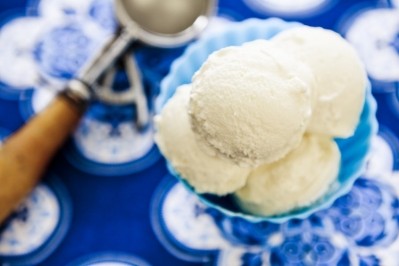Food tech naturally reduces sugar in fruit sorbets, ice cream

Developed by Israeli foodtech start-up Better Juice Ltd., the technology uses immobilized enzymes that naturally transform fruit juice’s sugar composition – e.g. sucrose, glucose and fructose – into prebiotic (non-digestible) fiber.
According to the company, fruit-based sorbets with as little as 2% sugar can be formulated through its technology, and leveraging it does not affect product texture, smell or other functional and sensory properties – though ‘a small amount’ of sweetness is taken away. This is crucial, since sugar not only acts as a flavor enhancer, but it also contributes to the texture of sorbets.
Nutrition also remains unaffected according to the company, with vitamin composition and other nutritional properties intact.
The solution also enables clean label formulations, since it doesn’t use genetically-modified (GMO) microorganisms.
From the bioreactor to the cone
Co-developed by Roni Shapira, PhD, a scientific advisor at the Hebrew University of Jerusalem, and Better Juice co-founder Eran Blachinsky, PhD, the technology is based around so-called immobilized microorganisms, which contain active enzymes.
The microorganisms are placed in a bioreactor, through which the fruit juice or puree is passed for de-sugaring. For example, the enzymes convert sucrose into dietary fiber, the glucose to gluconic acid, and the fructose to sorbitol. The treated product doesn’t contain the microorganisms but retains the converted compounds, e. g. the dietary fiber that sugar was transformed into.
What are immobilized microorganisms?
In cell engineering, immobilization refers to the process of confining cells to specific areas within a device or material without affecting their biological functions (see Sources below for more information). Immobilization could be achieved through microencapsulation, but other techniques also exist. Better Juice could not disclose the technique they used for commercial reasons, but told us that they use ‘a food-grade polymer to encapsulate the enzymes’.
The treated product can then pass through the rest of the production line and be prepared for packaging.
What’s healthier: sorbet or ice cream?
At the heart of Better Juice’s food technology is a quest to make indulgent frozen desserts like sorbets or ice cream healthier. Though the technology can be used to cut sugar in any fruit or fruit puree-based product, the company chose to focus on sorbets because there is demand for more nutritious formats in confectionery that do not sacrifice flavor.
In addition, consumers just ‘get’ sugar. In a 2022 study on consumer perceptions for better-for-you frozen desserts and ice cream, the researchers found that shoppers preferred naturally sweetened products, and almost twice as many viewed sugar as ‘natural’ compared to popular sweeteners like stevia. Overall however, flavor rather than healthiness was perceived as the most important factor in better-for-you ice cream and frozen desserts (see Sources below for more information on this study).
Sorbet is typically perceived as a healthier alternative to ice cream due to its lower fat and calorie content. But according to Karen Collins, nutrition advisor for the American Institute for Cancer Research, sorbet’s high sugar content can make it just as calorific as some lighter ice cream or frozen dairy yogurt options.
Better Juice co-founder and CEO Gali Yarom agrees. “Even products claiming zero added sugar still house approximately 6-10% sugar from the fruit juice concentrates alone,” she explained.
On top of that, sorbet’s glycemix index (GI) typically surpasses that of ice cream because it contains sugar from the fruits and no or lower amounts of fat, leading to quicker absorption of sugars into the bloodstream.
“We succeeded in creating delicious sorbets with as little as 2% sugar,” Yarom continued. “Our treated sorbets possess a more gentle sweetness yet retain all their characteristic fruity notes and flavor. The have fewer calories and a lower GI.”
GRAS certification and future focus
Besides fruit sorbets, the technology can be leveraged to de-sugar any product that contains real fruit, including jams and fruit roll-ups, which Better Juice is planning to apply its technology on next.
The company also recently obtained self-affirmed GRAS (standing for generally recognized as safe) by the US Food and Drug Administration, paving the way for commercialization in the US. This is what the firm is planning next – commercialize its solution for sorbet and ice cream products, with the view to extending its offering to Europe and other regions later on.
“This accomplishment showcases our ability to broaden the scope of applications that our technology can apply to,” said Eran Blachinsky, PhD, co-founder and CTO of Better Juice. “Its potential goes beyond just fruit juices to any product that contains real fruit components, such as jams and fruit roll-ups which are also in the pipeline for a Better Juice sugar reduction makeover. We deliver good news to consumers who are consciously seeking to reduce their sugar intake or with sugar sensitivities without having to give up the enjoyment of these sweet delights.”
The company also has an active collaboration with ingredients company Ingredion Incorporated, who through its venture investment arm will lead a Series A funding round for the Israeli start-up with the view to accelerate the adoption of Better Juice’s sugar reduction technology in the States.
For now, the plan is to offer its sugar reduction technology - complete with its bioreactors that contain the immobilized enzymes - to ice cream chains and CPG ice cream and sorbet manufacturers. Alternatively, the units can be installed at B2B or B2C juice manufacturers' factories through direct agreements with the Israeli company.
Sources:
Najim, A.A., Radeef, A.Y., al-Doori, I. and Jabbar, Z.H. (2024), Immobilization: the promising technique to protect and increase the efficiency of microorganisms to remove contaminants. J Chem Technol Biotechnol. https://doi.org/10.1002/jctb.7638
L.R. Sipple, C.M. Racette, A.N. Schiano, M.A. Drake, Consumer perception of ice cream and frozen desserts in the “better-for-you” category, Journal of Dairy Science, Volume 105, Issue 1, 2022, Pages 154-169, ISSN 0022-0302, https://doi.org/10.3168/jds.2021-21029











